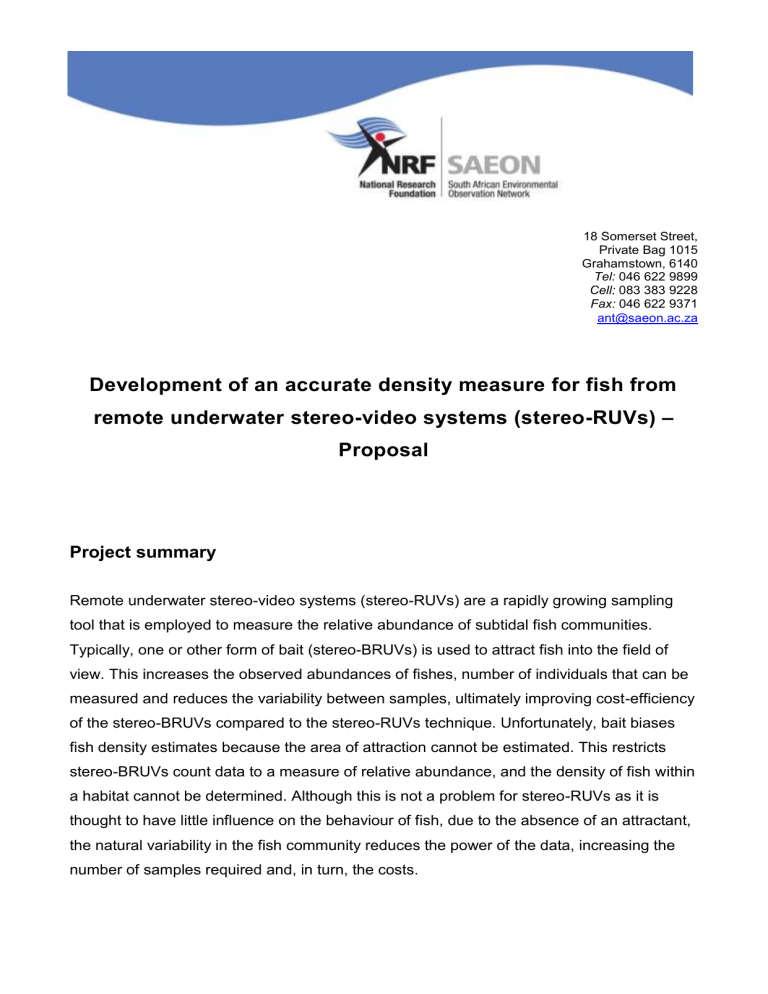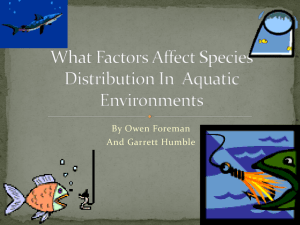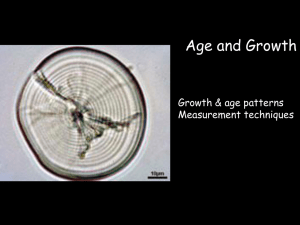Study sites

18 Somerset Street,
Private Bag 1015
Grahamstown, 6140
Tel: 046 622 9899
Cell: 083 383 9228
Fax: 046 622 9371 ant@saeon.ac.za
Development of an accurate density measure for fish from remote underwater stereo-video systems (stereo-RUVs)
–
Proposal
Project summary
Remote underwater stereo-video systems (stereo-RUVs) are a rapidly growing sampling tool that is employed to measure the relative abundance of subtidal fish communities.
Typically, one or other form of bait (stereo-BRUVs) is used to attract fish into the field of view. This increases the observed abundances of fishes, number of individuals that can be measured and reduces the variability between samples, ultimately improving cost-efficiency of the stereo-BRUVs compared to the stereo-RUVs technique. Unfortunately, bait biases fish density estimates because the area of attraction cannot be estimated. This restricts stereo-BRUVs count data to a measure of relative abundance, and the density of fish within a habitat cannot be determined. Although this is not a problem for stereo-RUVs as it is thought to have little influence on the behaviour of fish, due to the absence of an attractant, the natural variability in the fish community reduces the power of the data, increasing the number of samples required and, in turn, the costs.
Typically, abundance from video samples is determined with a measure called MaxN , defined as the maximum number of individuals of one species visible in one frame at any point during the video sample. For the baited videos, MaxN is thought to underestimate the number of fish in the field of view, due to fish clustering around the bait thereby obscuring individuals in the background. Although this is typically not the case with unbaited videos due to lower numbers of fish in the field of view, MaxN still overestimates the density of fish
(average number of individuals per area) in both methods as it does not provide an instantaneous measure of abundance and waits for fish to randomly accumulate in the field of view. For studies that wish to estimate density of fish from stereo-RUVs samples an alternative measure to MaxN is required.
The aim of this study is to develop a technique for accurately estimating density of species from stereo-RUV samples. In addition, due to the increased cost efficiency of stereo-
BRUVs the possibility of using a correction factor to account for the bias of bait and the larger area of attraction will be investigated.
Research Questions
Part 1: Accounting for initial attraction of the stereo-RUVs landing on the sea floor.
1. Past experience suggests that the system landing on the seafloor disturbs the fish community, if this is the case is the response of different species predictable?
2. How does this response affect abundance measures?
3. Can reliable species-specific acclimation periods be calculated to remove the effect of the system landing on the seafloor?
Part 2: An instantaneous repeated measure of abundance from stereo-RUVs samples.
1. Can instantaneous measurements repeated at different times within a video be used to estimate fish density from stereo-RUVs samples using generalised linear or generalised additive mixed effects models?
2. If an instantaneous repeated measure of abundance is equivalent to fish density, then what is the effect of this analysis method on actual fish diversity within the video?
Part 3: From stereo-RUVs to stereo-BRUVs. Can a reliable conversion factor be calculated that derives density estimates from stereo-BRUVs samples?
1. How does the density estimate from stereo-RUVs samples compare to the relative abundance estimate from stereo-BRUVs samples?
2. Is the bait effect on key species predictable under uncontrolled oceanographic conditions?
3. Can the area of attraction be estimated by the ratio of BRUVs to RUVs abundance measures?
Research approach
Part 1
S TUDY SITES
False Bay, De Hoop MPA, Goukamma MPA, Natures Valley, Tsitsikamma National
Park MPA, Algoa Bay, Port Alfred, Pondoland MPA.
D ATA COLLECTION
Using existing data (supplemented if needed)
It is estimated that between 32 and 50 samples from at least three locations within the Agulhas Ecoregion will need to be analysed.
A NALYSIS APPROACH
Divide videos into multiple 5min subsections (12 sections = 60min deployment).
Using the traditional MaxN approach, estimate relative abundance of each species within each subsection
Model the change in abundance with time using generalised mixed effects regression models (GLMMs or GAMMs)
Calculate the first point in time from which the abundance is stable within the video using simulation techniques
Part 2
S TUDY SITES
Large marine tanks at the uShaka and Two Oceans oceanariums
D ATA COLLECTION
Working in locations with a known density of individuals per species, collect multiple stereo-RUVs samples
Implications for aquariums:
Research will take place over a period of 5 days. Days do not need to be consecutive and can be agreed upon by the oceanarium management to minimise the disturbance.
Depending on the size of the tank, one or two stereo-RUV systems will be deployed simultaneously on the bottom of the tank. The systems will be left undisturbed on the bottom of the tank for a period of one hour. During this time it would be required that no swimmers/divers enter the tank, and that the fish are not fed.
On each of the five days, the one hour stereo-RUVs deployments will be replicated three times. The interval between deployments needs to be greater than or equal to
1 hour.
If only one system can be deployed in a tank then the number of research days would need to increase.
The ideal number of samples collected would be between 20 and 30 per oceanarium.
A NALYSIS APPROACH :
Determine a video analysis procedure that is based on repeated fish counts from a deployment to determine number of frames and the random sampling approach to sample the frames from a video.
Make use of generalised linear (or additive) mixed effects models and capture mark recapture analysis techniques to estimate density.
Part 3
S TUDY SITES
Tsitsikamma National Park MPA and Natures Valley
D ATA COLLECTION
Repeated sampling (first with stereo-RUVs and then with stereo-BRUVs) of randomly selected positions at both sites.
A NALYSIS APPROACH
Analyse stereo-RUVs with newly developed approach
Analyse stereo-BRUVs with MaxN approach
Determine effect size between samples
Determine the area of attraction from the stereo-BRUVs samples
Calculate the repeatability of the approach
Timeframe
P ART 1
January – June 2014
P ART 2
July – October 2014
P ART 3
November 2014 – March 2015
Manpower
Dr Anthony Bernard (first supervisor)
Dr Albrecht Götz (co-supervisor)
Denham Parker (co-supervisor)
Fulltime MSc
Material
Superduck Honkenii (8m) with capstan winch
Boat fuel and oil (~500l)
Four stereo-B/RUVs
External hard-drives (4 x 3 Terabyte)
Pilchard bait (~50kg)
Expected outcomes
1. One MSc student
2. Two papers published in peer reviewed journals
3. One conference proceeding
4. Training and education material
Budget:
Running costs carried by guaranteed SAEON Elwandle
MSc student bursary to be sourced from Rhodes University, NRF and SAEON.
Availability and amount will depend on the merit of the applicant and cannot be guaranteed.
Application
Interested students can apply directly to SAEON Elwandle:
046 622 9899; Ant or Ali: ant@saeon.ac.za
and/or albrecht@saeon.ac.za
Please include a CV and short motivation.









